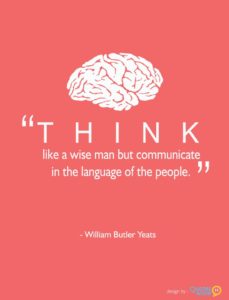 Last week, I had the pleasure of presenting at the Food Lifeline conference. Everyone in the room worked or volunteered with a food bank/pantry. They are, as I like to say, foodies.
Last week, I had the pleasure of presenting at the Food Lifeline conference. Everyone in the room worked or volunteered with a food bank/pantry. They are, as I like to say, foodies.
As I usually do when I have a captive audience, I was harshing on the verb ‘provide’. I explained, as I have many times before, that ‘provide’ is quite possibly the lamest of all verbs a nonprofit could use. It’s boring. Everyone uses it. And, therefore, it does nothing to differentiate you from every other organization. Bad verb, bad.
I have publicly pontificated about my disdain for ‘provide’ in front of thousands of people. Grad students at the University of Washington, Seattle University and the University of Chicago. Hard-working do-gooders in Arizona. Executive Directors visiting from Russia. All of them, plus a whole bunch of others, have heard me go off on ‘provide’. People general nod and agree that it is, in fact, rather lame. No one has ever questioned my vehement disapproval of this seemingly innocuous verb (possibly because after my anti-‘provide’ diatribe they are afraid of me, but let’s assume it’s because they agree that better verbs abound).
So imagine my surprise and delight when a woman came up to me at the Food Lifeline talk and said, “I get that provide doesn’t necessarily differentiate us. But beyond that, why do you dislike it so much?”
Since no one had ever asked me this before, I hadn’t given it much thought, to be honest. I just really, really, really don’t like it. Once asked, I realized it was a bit weird to dislike a word as much as I dislike ‘provide’. Her question forced me to think more deeply about why ‘provide’ gets me so riled up. It’s not like it’s the only lame word out there.
I started to feel badly for lil ol’ ‘provide’. I thought to myself, “It’s just a verb trying its darnedest to be useful, Erica. Stop picking on it.” Then I snapped out of it.
The brave woman who asked me about ‘provide’ made me realize that, in addition to being overused, the reason I don’t think ‘provide’ is a good word choice is because it implies a one-way street. You provide something to someone. No reciprocity. No two-way street.
And yet, most nonprofits exist to make the world a better place for a group of people–kids, cancer patients, low-income people living with HIV/AIDS, homeless families, victims of domestic abuse, etc etc etc. These people deserve the dignity of a verb that acknowledges that your organization gets as much from them as they do from you.
And so I’ve come full circle–I’m back to really, really, really disliking the verb ‘provide’. There are better verbs out there. Pretty please with sugar on top, go find them!







 I love French. I really do. The way everything sounds so sophisticated and deep, even if they’re really just talking about grocery shopping or mowing the lawn.
I love French. I really do. The way everything sounds so sophisticated and deep, even if they’re really just talking about grocery shopping or mowing the lawn.